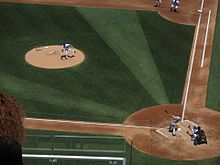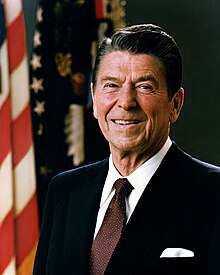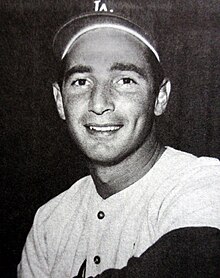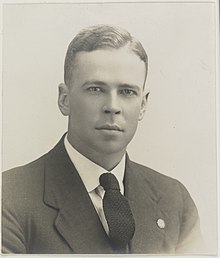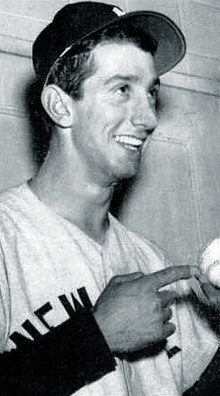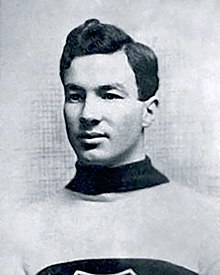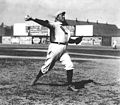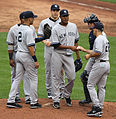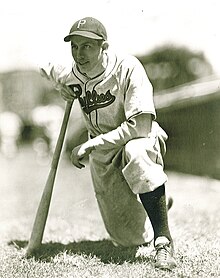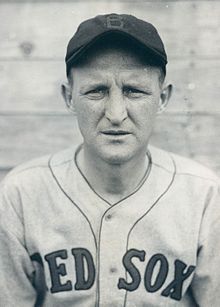Portal:Baseball
Portal maintenance status: (June 2018)
|
| Main page | Content, Categories & Topics | WikiProjects & Things you can do |
The Baseball Portal
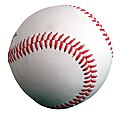
Baseball is a bat-and-ball sport played between two teams of nine players each, taking turns batting and fielding. The game occurs over the course of several plays, with each play generally beginning when a player on the fielding team, called the pitcher, throws a ball that a player on the batting team, called the batter, tries to hit with a bat. The objective of the offensive team (batting team) is to hit the ball into the field of play, away from the other team's players, allowing its players to run the bases, having them advance counter-clockwise around four bases to score what are called "runs". The objective of the defensive team (referred to as the fielding team) is to prevent batters from becoming runners, and to prevent runners advancing around the bases. A run is scored when a runner legally advances around the bases in order and touches home plate (the place where the player started as a batter).
The opposing teams switch back and forth between batting and fielding; the batting team's turn to bat is over once the fielding team records three outs. One turn batting for each team constitutes an inning. A game is usually composed of nine innings, and the team with the greater number of runs at the end of the game wins. Most games end after the ninth inning, but if scores are tied at that point, extra innings are usually played. Baseball has no game clock, though some competitions feature pace-of-play regulations such as the pitch clock to shorten game time.
Baseball evolved from older bat-and-ball games already being played in England by the mid-18th century. This game was brought by immigrants to North America, where the modern version developed. Baseball's American origins, as well as its reputation as a source of escapism during troubled points in American history such as the American Civil War and the Great Depression, have led the sport to receive the moniker of "America's Pastime"; since the late 19th century, it has been unofficially recognized as the national sport of the United States, though in modern times is considered less popular than other sports, such as American football. In addition to North America, baseball spread throughout the rest of the Americas and the Asia–Pacific in the 19th and 20th centuries, and is now considered the most popular sport in parts of Central and South America, the Caribbean, and East Asia, particularly in Japan, South Korea, and Taiwan. (Full article...)
 Featured articles - load new batch
Featured articles - load new batch
-
Image 1
Ronald Wilson Reagan (February 6, 1911 – June 5, 2004) was an American politician and actor who served as the 40th president of the United States from 1981 to 1989. He was a member of the Republican Party and became an important figure in the American conservative movement. His presidency is known as the Reagan era.
Born in Illinois, Reagan graduated from Eureka College in 1932 and was hired the next year as a sports broadcaster in Iowa. In 1937, he moved to California where he became a well-known film actor. During his acting career, Reagan was president of the Screen Actors Guild twice, from 1947 to 1952 and from 1959 to 1960. In the 1950s, he hosted General Electric Theater and worked as a motivational speaker for General Electric. Reagan's "A Time for Choosing" speech during the 1964 presidential election launched his rise as a leading conservative figure. After being elected governor of California in 1966, he raised state taxes, turned the state budget deficit into a surplus and implemented harsh crackdowns on university protests. Following his loss to Gerald Ford in the 1976 Republican Party presidential primaries, Reagan won the Republican Party's nomination and then a landslide victory over President Jimmy Carter in the 1980 presidential election. (Full article...) -
Image 2
Sanford Koufax (/ˈkoʊfæks/; né Braun; born December 30, 1935), nicknamed "the Left Arm of God", is an American former baseball pitcher who played 12 seasons in Major League Baseball (MLB) for the Brooklyn/Los Angeles Dodgers from 1955 to 1966. Widely regarded as one of the greatest pitchers in baseball history, Koufax was the first three-time winner of the Cy Young Award, each time winning unanimously and the only pitcher to do so when a single award was given for both the leagues; he was also named the National League Most Valuable Player in 1963. Retiring at the age of 30 due to chronic pain in his pitching elbow, Koufax was elected to the Baseball Hall of Fame in his first year of eligibility in 1972 at the age of 36, the youngest player ever elected.
Born in Brooklyn, New York, Koufax was primarily a basketball player in his youth and had pitched in only a few games before signing with the Brooklyn Dodgers at age 19. Due to the bonus rule he signed under, Koufax never pitched in the minor leagues. His lack of pitching experience caused manager Walter Alston to distrust Koufax, who saw inconsistent playing time during his first six seasons. As a result, though he often showed flashes of brilliance, Koufax struggled early on. Frustrated with the way he was being managed by the Dodgers, he almost quit after the 1960 season. After making adjustments prior to the 1961 season, Koufax quickly rose to become the most dominant pitcher in the major leagues, as well as the first major sports star on the West Coast. He was an All-Star in each of his last six seasons, leading the National League (NL) in earned run average each of his last five years, in strikeouts four times, and in wins and shutouts three times each. He was the first pitcher in the live-ball era to post an earned run average below 2.00 in three different qualifying seasons, and the first in the modern era to record a 300-strikeout season three times. (Full article...) -
Image 3
William Harold Ponsford MBE (19 October 1900 – 6 April 1991) was an Australian cricketer. Usually playing as an opening batsman, he formed a successful and long-lived partnership opening the batting for Victoria and Australia with Bill Woodfull, his friend and state and national captain. Ponsford is the only player to twice break the world record for the highest individual score in first-class cricket; Ponsford and Brian Lara are the only cricketers to twice score 400 runs in an innings. Ponsford holds the Australian record for a partnership in Test cricket, set in 1934 in combination with Don Bradman (451 for 2nd wicket)—the man who broke many of Ponsford's other individual records. In fact, he along with Bradman set the record for the highest partnership ever for any wicket in Test cricket history when playing on away soil (451 runs for the second wicket)
Despite being heavily built, Ponsford was quick on his feet and renowned as one of the finest ever players of spin bowling. His bat, much heavier than the norm and nicknamed "Big Bertha", allowed him to drive powerfully and he possessed a strong cut shot. However, critics questioned his ability against fast bowling, and the hostile short-pitched English bowling in the Bodyline series of 1932–33 was a contributing factor in his early retirement from cricket a year and a half later. Ponsford also represented his state and country in baseball, and credited the sport with improving his cricketing skills. (Full article...) -
Image 4
George Herman "Babe" Ruth (February 6, 1895 – August 16, 1948) was an American professional baseball player whose career in Major League Baseball (MLB) spanned 22 seasons, from 1914 through 1935. Nicknamed "the Bambino" and "the Sultan of Swat", he began his MLB career as a star left-handed pitcher for the Boston Red Sox, but achieved his greatest fame as a slugging outfielder for the New York Yankees. Ruth is regarded as one of the greatest sports heroes in American culture and is considered by many to be the greatest baseball player of all time. In 1936, Ruth was elected to the Baseball Hall of Fame as one of its "first five" inaugural members.
At age seven, Ruth was sent to St. Mary's Industrial School for Boys, a reformatory where he was mentored by Brother Matthias Boutlier of the Xaverian Brothers, the school's disciplinarian and a capable baseball player. In 1914, Ruth was signed to play Minor League baseball for the Baltimore Orioles but was soon sold to the Red Sox. By 1916, he had built a reputation as an outstanding pitcher who sometimes hit long home runs, a feat unusual for any player in the dead-ball era. Although Ruth twice won 23 games in a season as a pitcher and was a member of three World Series championship teams with the Red Sox, he wanted to play every day and was allowed to convert to an outfielder. With regular playing time, he broke the MLB single-season home run record in 1919 with 29. (Full article...) -
Image 5
James Francis Thorpe (Meskwaki: Wa-Tho-Huk, May 22 or 28, 1887 – March 28, 1953) was an American athlete and Olympic gold medalist. A citizen of the Sac and Fox Nation, Thorpe was the first Native American to win a gold medal for the United States in the Olympics. Considered one of the most versatile athletes of modern sports, he won two Olympic gold medals in the 1912 Summer Olympics (one in classic pentathlon and the other in decathlon). He also played football (collegiate and professional), professional baseball, and professional basketball.
He lost his Olympic titles after it was found he had been paid for playing two seasons of semi-professional baseball before competing in the Olympics, thus violating the contemporary amateurism rules. In 1983, 30 years after his death, the International Olympic Committee (IOC) restored his Olympic medals with replicas, after ruling that the decision to strip him of his medals fell outside of the required 30 days. Official IOC records still listed Thorpe as co-champion in decathlon and pentathlon until 2022, when it was decided to restore him as the sole champion in both events. (Full article...) -
Image 6
Alfred Manuel "Billy" Martin Jr. (May 16, 1928 – December 25, 1989) was an American Major League Baseball second baseman and manager who, in addition to leading other teams, was five times the manager of the New York Yankees. First known as a scrappy infielder who made considerable contributions to the championship Yankee teams of the 1950s, he then built a reputation as a manager who would initially make bad teams good, before ultimately being fired amid dysfunction. In each of his stints with the Yankees he managed them to winning records before being fired by team owner George Steinbrenner or resigning under fire, usually amid a well-publicized scandal such as Martin's involvement in an alcohol-fueled fight.
Martin was born in a working-class section of Berkeley, California. His skill as a baseball player gave him a route out of his home town. Signed by the Pacific Coast League Oakland Oaks, Martin learned much from Casey Stengel, the man who would manage him both in Oakland and in New York, and enjoyed a close relationship with Stengel. Martin's spectacular catch of a wind-blown Jackie Robinson popup late in Game Seven of the 1952 World Series saved that series for the Yankees, and he was the hitting star of the 1953 World Series, earning the Most Valuable Player award in the Yankee victory. He missed most of two seasons, 1954 and 1955, after being drafted into the Army, and his abilities never fully returned; the Yankees traded him after a brawl at the Copacabana club in New York during the 1957 season. Martin bitterly resented being traded, and did not speak to Stengel for years, a time during which Martin completed his playing career with various teams. (Full article...) -
Image 7
Derek Sanderson Jeter (/ˈdʒiːtər/ JEE-tər; born June 26, 1974), nicknamed "the Captain", is an American former professional baseball shortstop, businessman, and baseball executive. As a player, Jeter spent his entire 20-year Major League Baseball (MLB) career with the New York Yankees. He was elected to the Baseball Hall of Fame in his first year of eligibility in 2020; he received 396 of 397 possible votes, the second-highest percentage in MLB history (behind only teammate Mariano Rivera) and the highest by a position player. He was the chief executive officer (CEO) and part owner of the league's Miami Marlins from September 2017 to February 2022.
A five-time World Series champion with the Yankees, Jeter is regarded as a central contributor to the franchise's dynasty during the late 1990s and early 2000s for his hitting, base-running, fielding, and leadership. He is the Yankees' all-time career leader in hits (3,465), doubles (544), games played (2,747), stolen bases (358), times on base (4,716), plate appearances (12,602) and at bats (11,195). His accolades include 14 All-Star selections, five Gold Glove Awards, five Silver Slugger Awards, two Hank Aaron Awards, and a 2009 Roberto Clemente Award. Jeter was the 28th player to reach 3,000 hits and finished his career ranked sixth in MLB history in career hits and first among shortstops. In 2017, the Yankees retired his uniform number 2. (Full article...) -
Image 8
Osborne Earl Smith (born December 26, 1954) is an American former professional baseball player. Nicknamed "The Wizard of Oz", Smith played shortstop for the San Diego Padres and St. Louis Cardinals in Major League Baseball, winning the National League Gold Glove Award for defensive play at shortstop for 13 consecutive seasons. A 15-time All-Star, Smith accumulated 2,460 hits and 580 stolen bases during his career, and won the National League Silver Slugger Award as the best hitter at shortstop in 1987. He was elected to the Baseball Hall of Fame in his first year of eligibility in 2002. He was also elected to the St. Louis Cardinals Hall of Fame in the inaugural class of 2014.
Smith was born in Mobile, Alabama; his family moved to Watts, Los Angeles, when he was six years old. While participating in childhood athletic activities, Smith possessed quick reflexes; he went on to play baseball at Locke High School in Los Angeles, then at California Polytechnic State University, San Luis Obispo. Drafted as an amateur player by the Padres, Smith made his major league debut in 1978. He quickly established himself as an outstanding fielder, and later became known for performing backflips on special occasions while taking his position at the beginning of a game. Smith won his first Gold Glove Award in 1980 and made his first All-Star Game appearance in 1981. (Full article...) -
Image 9
Riders Field, formerly known as Dr Pepper/Seven Up Ballpark and Dr Pepper Ballpark, is a baseball park in Frisco, Texas, United States. The home of the Double-A Frisco RoughRiders of the Texas League, it opened on April 3, 2003, and can seat up to 10,216 people. Though primarily a venue for Minor League Baseball games, the facility also hosts high school and college baseball tournaments, and other public and private events throughout the year. It has been the site of three Texas League All-Star Games.
Since its opening, Riders Field has won awards and garnered praise for its unique design, feel, and numerous amenities. In his design, park architect David M. Schwarz desired the creation of a village-like "park within a (ball)park". The stadium received the 2003 Texas Construction Award for Best Architectural Design. (Full article...) -
Image 10
Arthur Joseph Houtteman (August 7, 1927 – May 6, 2003) was an American right-handed pitcher in Major League Baseball who played for 12 seasons in the American League with the Detroit Tigers, Cleveland Indians and Baltimore Orioles. In 325 career games, Houtteman pitched 1,555 innings and posted a win–loss record of 87–91, with 78 complete games, 14 shutouts, and a 4.14 earned run average (ERA).
Known on the sandlot for his pitching motion, Houtteman was signed by scout Wish Egan in 1945 at 17 years of age. He was recruited by major league teams, and joined a Tigers pitching staff that had lost players to injuries and World War II. After moving between the major and minor leagues over the next few years, he was nearly killed in an automobile accident just before the 1949 season. Houtteman rebounded from his injuries and went on to win 15 games that season and made his only All-Star appearance in the following year. (Full article...) -
Image 11
Marcus Elmore Baldwin (October 29, 1863 – November 10, 1929), nicknamed "Fido" and "Baldy", was an American professional baseball pitcher who played seven seasons in Major League Baseball (MLB). In 346 career games, he pitched to a 154–165 win–loss record with 295 complete games. Baldwin set the single-season MLB wild pitches record with 83 that still stands today.
Born in Pittsburgh, Pennsylvania, Baldwin made his professional debut for a Cumberland, Maryland, team in 1883. Though signed by Chicago White Stockings president Albert Spalding to pitch against the St. Louis Browns in the 1886 World Series, Baldwin did not play after the Browns objected. He made his MLB debut for the White Stockings in 1887, when a writer for the Oshkosh Daily Northwestern called him the "swiftest pitcher in the National League" (NL). Released by Chicago player–manager Cap Anson, he signed with the Columbus Solons of the American Association (AA) in 1889, where he led the league in innings pitched (513+2⁄3), losses (34), strikeouts (368), and walks (274). (Full article...) -
Image 12
Morris Berg (March 2, 1902 – May 29, 1972) was an American professional baseball catcher and coach in Major League Baseball who later served as a spy for the Office of Strategic Services during World War II. He played 15 seasons in the major leagues, almost entirely for four American League teams, though he was never more than an average player and was better known for being "the brainiest guy in baseball." Casey Stengel once described Berg as "the strangest man ever to play baseball."
Berg was a graduate of Princeton University and Columbia Law School, spoke several languages, and regularly read ten newspapers a day. His reputation as an intellectual was fueled by his successful appearances as a contestant on the radio quiz show Information Please, in which he answered questions about the etymology of words and names from Greek and Latin, historical events in Europe and the Far East, and ongoing international conferences. (Full article...) -
Image 13Ross with the Montreal Wanderers, circa 1907–18
Arthur Howey Ross (January 13, 1885 – August 5, 1964) was a Canadian professional ice hockey player and executive from 1905 until 1954. Regarded as one of the best defenders of his era by his peers, he was one of the first to skate with the puck up the ice rather than pass it to a forward. He was on Stanley Cup championship teams twice in a playing career that lasted thirteen seasons; in January 1907 with the Kenora Thistles and 1908 with the Montreal Wanderers. Like other players of the time, Ross played for several different teams and leagues, and is noted for his time with the Wanderers while they were members of the National Hockey Association (NHA) and its successor, the National Hockey League (NHL). In 1911, he led one of the first organized player strikes over increased pay. When the Wanderers' home arena burned down in January 1918, the team ceased operations and Ross retired as a player.
After several years as an on-ice official, he was named head coach of the Hamilton Tigers for one season. When the Boston Bruins were formed in 1924, Ross was hired as the first coach and general manager of the team. He later coached the team on three separate occasions until 1945, and stayed as general manager until his retirement in 1954. Ross helped the Bruins finish first place in the league ten times and win the Stanley Cup three times; Ross personally coached the team to two of those victories. After being hired by the Bruins, Ross, along with his wife and two sons, moved to a suburb of Boston, and he became an American citizen in 1938. He died near Boston in 1964. (Full article...) -
Image 14William Derrick Bates (born December 7, 1963) is an American former professional baseball second baseman and pinch runner who played in Major League Baseball (MLB) for the Milwaukee Brewers and the Cincinnati Reds. In 29 career games, Bates had a batting average of .125 with six hits, two runs batted in (RBI), 11 runs, and eight stolen bases. Though his defensive position was at second base, the Reds primarily used Bates as a pinch runner. After he scored the winning run in Game 2 of the 1990 World Series, Bates never played in MLB again.
Born in Houston, Bates attended the University of Texas and, in his freshman season, won the 1983 College World Series as a part of the Texas Longhorns baseball team. For the next two seasons, Bates was named to the College Baseball All-America Team, a team composed of the best collegiate baseball athletes in America. Drafted by Milwaukee in the fourth round of the 1985 MLB draft, he rose through the Brewers' farm system helping several of his minor league teams win their respective league titles. He made his MLB debut in 1989, after Milwaukee's starting second baseman Jim Gantner was injured. A trade in 1990 sent Bates to Cincinnati, where the Reds used him primarily as a pinch runner at the end of the regular season and into the postseason. Facing the Oakland Athletics in the World Series, Bates reached base on a pinch hit single against Dennis Eckersley and later scored the winning run in Game 2 as the Reds swept the Athletics four games to none. Following the World Series championship, the Reds re-signed Bates on a one-year contract, and he played for their Triple-A team. He spent the next year with the Chicago Cubs Triple-A affiliate, and last played exhibition baseball in 1995. After retiring, he worked as an equipment supplier in the oil and gas industry in Houston. (Full article...) -
Image 15

WSNS-TV (channel 44) is a television station in Chicago, Illinois, United States, serving as the local outlet for the Spanish-language network Telemundo. It is owned and operated by NBCUniversal's Telemundo Station Group alongside NBC outlet WMAQ-TV (channel 5). The two stations share studios at the NBC Tower on North Columbus Drive in the city's Streeterville neighborhood and broadcast from the same transmitter atop the Willis Tower in the Chicago Loop.
WSNS-TV began broadcasting in 1970. Originally specializing in the automated display of news headlines, it evolved into Chicago's third full-fledged independent station, carrying movies, local sports, and other specialty programming. This continued until 1980, when WSNS became the Chicago-area station for ON TV, an over-the-air subscription television (STV) service owned by Oak Industries, which took a minority ownership stake in the station. While ON TV was successful in Chicago and the subscription system became the second-largest in the country by total subscribers, the rise of cable television precipitated the end of the business in 1985, with WSNS-TV as the last ON TV station standing. (Full article...)
General images - load new batch
-
Image 2A New York Yankees batter (Andruw Jones) and a Boston Red Sox catcher at Fenway Park (from Baseball)
-
Image 3Diagram indicating the standard layout of positions (from Baseball)
-
Image 4Cover of Official Base Ball Rules, 1921 edition, used by the American League and National League (from Baseball rules)
-
Image 8A runner sliding into home plate and scoring. (from Baseball)
-
Image 9Sadaharu Oh managing the Japan national team in the 2006 World Baseball Classic. Playing for the Central League's Yomiuri Giants (1959–80), Oh set the professional world record for home runs with 868. (from History of baseball)
-
Image 10The strike zone determines the result of most pitches, and varies in vertical length for each batter. (from Baseball)
-
Image 11In May 2010, the Philadelphia Phillies' Roy Halladay pitched the 20th major league perfect game. That October, he pitched only the second no-hitter in MLB postseason history. (from History of baseball)
-
Image 12Alexander Cartwright, father of modern baseball (from History of baseball)
-
Image 14Cy Young—the holder of many major league career marks, including wins and innings pitched, as well as losses—in 1908. MLB's annual awards for the best pitcher in each league are named for Young. (from Baseball)
-
Image 15A game from the Cantigas de Santa Maria, c. 1280, involving tossing a ball, hitting it with a stick and competing with others to catch it (from History of baseball)
-
Image 16An Afghan girl playing baseball in August 2002 (from Baseball)
-
Image 17Jackie Robinson in 1945, with the era's Kansas City Royals, a barnstorming squad associated with the Negro American League's Kansas City Monarchs (from Baseball)
-
Image 18A first baseman receives a pickoff throw, as the runner dives back to first base. (from Baseball)
-
Image 19Baseball games sometimes end in a walk-off home run, with the batting team usually gathering at home plate to celebrate the scoring of the winning run(s). (from Baseball rules)
-
Image 20Pick-off attempt on runner (in red) at first base (from Baseball rules)
-
Image 21The American Tobacco Company's line of baseball cards featured shortstop Honus Wagner of the Pittsburgh Pirates from 1909 to 1911. In 2007, the card shown here sold for $2.8 million. (from Baseball)
-
Image 22Japanese-Americans spectating a World War II-era game while in an internment camp. America's ties to immigrants and to Japan have been deeply shaped by a shared baseball heritage. (from History of baseball)
-
Image 23Rickey Henderson—the major leagues' all-time leader in runs and stolen bases—stealing third base in a 1988 game (from Baseball)
-
Image 24Baserunners generally stand a short distance away from their base between pitches, preparing themselves to either go back or steal the next base. (from Baseball rules)
-
Image 26Sadaharu Oh managing the Japan national team in the 2006 World Baseball Classic. Playing for the Central League's Yomiuri Giants (1959–80), Oh set the professional world record for home runs. (from Baseball)
-
Image 27Jackie Robinson in 1945, with the era's Kansas City Royals, a barnstorming squad associated with the Negro American League's Kansas City Monarchs (from History of baseball)
-
Image 28A batter follows through after swinging at a pitched ball. (from Baseball rules)
-
Image 292013 World Baseball Classic championship match between the Dominican Republic and Puerto Rico, March 20, 2013 (from Baseball)
-
Image 30A well-worn baseball (from Baseball)
-
Image 31Fenway Park, home of the Boston Red Sox. The Green Monster is visible beyond the playing field on the left. (from Baseball)
-
Image 32The typical motion of a right-handed pitcher (from Baseball rules)
-
Image 331906 World Series, infielders playing "in" for the expected bunt and the possible play at the plate with the bases loaded (from Baseball rules)
-
Image 35Pesäpallo, a Finnish variation of baseball, was invented by Lauri "Tahko" Pihkala in the 1920s, and after that, it has changed with the times and grown in popularity. Picture of Pesäpallo match in 1958 in Jyväskylä, Finland. (from Baseball)
-
Image 36By the 1860s Civil War, baseball (bottom) had overtaken its fellow bat-and-ball sport cricket (top) in popularity within the United States. (from History of baseball)
-
Image 37Pitchers are generally substituted during mound visits (team gatherings at the pitcher's mound). (from Baseball rules)
-
Image 38The standard fielding positions (from Baseball rules)
-
Image 39Diagram of a baseball field Diamond may refer to the square area defined by the four bases or to the entire playing field. The dimensions given are for professional and professional-style games. Children often play on smaller fields. (from Baseball)
-
Image 41The strike zone, which determines the outcome of most pitches, varies in vertical length depending on the batter's typical height while swinging. (from Baseball rules)
-
Image 42The NL champion New York Giants baseball team, 1913. Fred Merkle, sixth in line, had committed a baserunning gaffe in a crucial 1908 game that became famous as Merkle's Boner. (from History of baseball)
-
Image 43Two players on the baseball team of Tokyo, Japan's Waseda University in 1921 (from Baseball)
-
Image 45A pitcher handing off the ball after being taken out of the game during a mound meeting. (from Baseball)
 Good articles - load new batch
Good articles - load new batch
-
Image 1McGrady with the Houston Rockets in 2006
Tracy Lamar McGrady Jr. (born May 24, 1979), nicknamed T-Mac, is an American former professional basketball player, best known for his career in the National Basketball Association (NBA). McGrady is a seven-time NBA All-Star, seven-time All-NBA selection, two-time NBA scoring champion, and winner of the NBA Most Improved Player Award in 2001. He was inducted into the Naismith Memorial Basketball Hall of Fame as part of the Class of 2017. McGrady is regarded as one of the greatest scorers and shooting guards in NBA history.
McGrady entered the NBA straight out of high school and was selected as the ninth overall pick by the Toronto Raptors in the 1997 NBA draft. Beginning his career as a low-minute player, he gradually improved his role with the team, eventually forming a duo with his cousin Vince Carter. In 2000, he left the Raptors for the Orlando Magic, where he became one of the league's most prolific scorers and a candidate for the NBA Most Valuable Player Award. In 2004, he was traded to the Houston Rockets, where he paired with center Yao Ming to help the Rockets become a perennial playoff team. His final seasons in the NBA were plagued by injuries, and he retired in 2013 following a brief stint with the Qingdao DoubleStar Eagles of the Chinese Basketball Association (CBA) and the San Antonio Spurs. (Full article...) -
Image 2
Alfred Stanley Benjamin (May 20, 1914 – December 24, 2009) was a right fielder in Major League Baseball for five seasons; four with the Philadelphia Phillies (1939–42), of the National League (NL), and one with the Cleveland Indians (1945), of the American League (AL). The 6 ft 2 in (1.88 m), 194 lb (88 kg) Benjamin batted and threw right-handed, and was born in Framingham, Massachusetts. After graduating from high school, he attended Western Maryland College, now known as McDaniel College, where he played baseball, basketball, and football.
In addition to his major league playing career, he played in minor league baseball for ten seasons. He began at the age of 23, with the Thomasville Orioles of the Georgia–Florida League in 1937, and finished as the player-manager for the Fresno Cardinals of the California League in 1948. During that time, he played in 955 minor league games, and batted .304, and hit 52 home runs. In the early 1940s, he was an assistant football coach at Northeastern University. Later, during his minor league career, he began coaching high school football, part-time, in his home town of Framingham, and then full-time once his playing and managing career ended. (Full article...) -
Image 3
Benjamin José Molina (born July 20, 1974), nicknamed "Big Money", is a former Major League Baseball (MLB) catcher. He played for the Anaheim Angels / Los Angeles Angels of Anaheim (1998–2005), Toronto Blue Jays (2006), San Francisco Giants (2007–2010), and Texas Rangers (2010). He is the older brother of major league catchers José Molina and Yadier Molina.
Molina played a handful of games for the Anaheim Angels in 1998 and 1999. He became the Angels' regular catcher in 2000 and remained so through the 2005 season. In 2001, José became his teammate. Molina received his World Series ring in 2002 after the Angels defeated the Giants in the 2002 World Series. He won a Gold Glove in 2002 and 2003, leading American League (AL) catchers in percentage of attempted base stealers thrown out. (Full article...) -
Image 4Walter Francis O'Malley (October 9, 1903 – August 9, 1979) was an American sports executive who owned the Brooklyn / Los Angeles Dodgers team in Major League Baseball from 1950 to 1979. In 1958, as owner of the Dodgers, he brought major league baseball to the West Coast, moving the Dodgers from Brooklyn to Los Angeles despite the Dodgers being the second most profitable team in baseball from 1946 to 1956, and coordinating the move of the New York Giants to San Francisco at a time when there were no teams west of Kansas City, Missouri. In 2008, O'Malley was elected to the National Baseball Hall of Fame for his contributions to and influence on the game of baseball.
O'Malley's father, Edwin Joseph O'Malley, was politically connected. Walter, a University of Pennsylvania salutatorian, went on to obtain a Bachelor of Laws (LL.B.), and he used the combination of his family connections, his personal contacts, and both his educational and vocational skills to rise to prominence. First, he became an entrepreneur involved in public works contracting, and then he became an executive with the Dodgers. He progressed from being a team lawyer to being both the Dodgers' owner and president, and he eventually made the business decision to relocate the Dodgers franchise. Although he moved the franchise, O'Malley is known as a businessman whose major philosophy was stability through loyalty to and from his employees. (Full article...) -
Image 5
Samuel Timothy Coonrod (born September 22, 1992) is an American professional baseball pitcher who is a free agent. He has previously played in Major League Baseball (MLB) for the San Francisco Giants, Philadelphia Phillies, and New York Mets.
Coonrod was born in St. Louis, Missouri, and raised in Carrollton, Illinois. He played high school baseball at Carrollton High School, where he helped his team win a state championship his senior season and became the first player in school history to have his jersey number retired. After high school, Coonrod spent three years playing college baseball with the Southern Illinois Salukis of the Missouri Valley Conference. He also played for two collegiate summer baseball teams: the Quincy Gems in 2012 and the Yarmouth-Dennis Red Sox in 2013. (Full article...) -
Image 6
Gerald Donald Kindall (May 27, 1935 – December 24, 2017) was an American professional baseball player and college baseball player and coach. He was primarily a second baseman in Major League Baseball (MLB) who appeared in 742 games played over nine seasons for the Chicago Cubs (1956–58, 1960–61), Cleveland Indians (1962–64), and Minnesota Twins (1964–65). After his playing career, he became the head baseball coach of the University of Arizona Wildcats, winning 860 games and three College World Series (CWS) championships over 24 seasons (1973–1996). Kindall batted and threw right-handed and was listed as 6 feet 2 inches (1.88 m) tall and 175 pounds (79 kg).
Kindall was born in St. Paul, Minnesota, and graduated from Washington High School before attending the University of Minnesota. In 1956, as a student-athlete at Minnesota, his Golden Gophers won the NCAA Division I baseball championship. Twenty years later, Kindall coached the Arizona Wildcats to a CWS victory, becoming the first person to win CWS titles both as a player and as a head coach. He is also the first batter to hit for the cycle in the history of the CWS, along with being the only person to do so until Christian Moore did so in 2024. Kindall was elected to the College Baseball Hall of Fame in 2007. (Full article...) -
Image 7
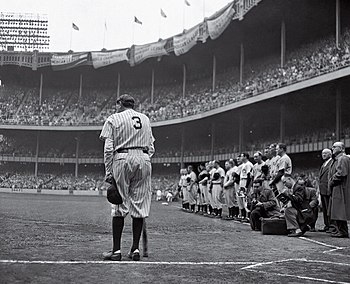
Babe Ruth Bows Out, June 13, 1948
Babe Ruth Bows Out, also known as The Babe Bows Out, is a 1948 photograph of Major League Baseball player Babe Ruth taken by New York Herald Tribune photographer Nathaniel Fein at Yankee Stadium in The Bronx. The picture won the 1949 Pulitzer Prize for Photography.
Ruth was photographed with his back turned to the camera; he was sick with throat cancer at the time and was leaning on a baseball bat for support. The New York Yankees were honoring Ruth by retiring his jersey number. It had been 14 years since he had played for the Yankees: he wore his number three Yankees uniform to celebrate the occasion. (Full article...) -
Image 8
Oliver Wall Kuhn (August 14, 1898 – October 8, 1968), nicknamed "Doc Kuhn", was an American football, baseball and basketball player for the Vanderbilt University Commodores and later a prominent businessman of Tampa, Florida. As a college football quarterback, Kuhn led Vanderbilt to three consecutive Southern titles in 1921, 1922, and 1923 – the most-recent conference titles for Vanderbilt football. In 1922, Vanderbilt tied Michigan at the dedication of Dudley Field, and Kuhn was picked for Walter Camp's list of names worthy of mention and Billy Evans' All-America "National Honor Roll."
During his senior year, Kuhn was the captain of Vanderbilt's football and basketball teams and received the Porter Cup, awarded to Vanderbilt's best all-around athlete. Kuhn played guard on the basketball team and was a shortstop on the baseball team which won a 1921 conference championship. He was selected All-Southern in baseball in 1921 and 1922. (Full article...) -
Image 9

The Philadelphia Phillies' 2014 season was the 132nd in the history of the franchise. After a disappointing 2013, the Phillies entered the offseason with a strategy to reload rather than rebuild; they did not want to relinquish the opportunity to do well in 2014 in hopes of being competitive down the road. Commensurate with this strategy, among their key acquisitions were right fielder Marlon Byrd and starting pitcher A. J. Burnett. The Phillies began the season with new coaches (as Ryne Sandberg entered his first season as manager after taking over on an interim basis in August 2013) and new broadcasters: Jamie Moyer and Matt Stairs, two members of the 2008 World Series squad, replaced Chris Wheeler and Gary Matthews as analysts on Comcast SportsNet Philadelphia.
After offseason headlines indicated a tenuous relationship between Sandberg and shortstop Jimmy Rollins and controversy about draft picks who did not sign with the team, the season began auspiciously with an opening-day win. However, the Phillies then lost their next two games. April continued in that fashion; the team played .500 ball in their first 26 games, exceeding expectations. One commentator called them "pleasantly mediocre", despite a horrific performance from the bullpen. May was a frustrating month for the Phillies; failing to win games they were in a position to win, they posted an 11–16 record and a .230 team batting average (the worst in the National League). June was almost as bad; although the team had 12 wins and 17 losses, the bullpen improved to one of the best in the NL. In the 2014 Major League Baseball draft that month the Phillies selected Aaron Nola as their first-round pick, encouraging optimism from fans and the media. Although the Phillies began July at the bottom of the National League East Division, they amassed a five-game winning streak shortly before the All-Star break. This moved them to within nine games of .500, but they lost the last two games and had a 42–53 record at the break. (Full article...) -
Image 10
Herbert Jefferis Pennock (February 10, 1894 – January 30, 1948) was an American professional baseball pitcher and front-office executive. He played in Major League Baseball from 1912 through 1933, and is best known for his time spent with the star-studded New York Yankee teams of the mid to late 1920s and early 1930s.
Pennock was signed by the Philadelphia Athletics in 1912, but was used sparingly by the Athletics and the Boston Red Sox, who bought his contract in 1915. After returning from military service in 1919, Pennock became a regular contributor for the Red Sox. The Yankees acquired Pennock after the 1922 season, and he served as a key member of the pitching staff as the Yankees won four World Series championships. After retiring as a player, Pennock served as a coach and farm system director for the Red Sox, and as general manager of the Philadelphia Phillies. (Full article...) -
Image 11
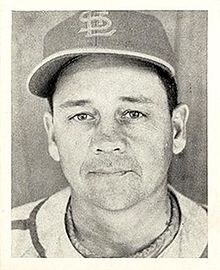
August Rodney Mancuso (December 5, 1905 – October 26, 1984), nicknamed "Blackie", was an American professional baseball player, coach, scout and radio sports commentator. He played as a catcher in Major League Baseball with the St. Louis Cardinals (1928, 1930–32, 1941–42), New York Giants (1933–38, 1942–44), Chicago Cubs (1939), Brooklyn Dodgers (1940) and Philadelphia Phillies (1945).
Mancuso was known for his capable handling of pitching staffs and for his on-field leadership abilities. He was a member of five National League pennant-winning teams, and played as the catcher for five pitchers who were eventually inducted into the Baseball Hall of Fame. Mancuso was regarded as one of the top defensive catchers of the 1930s. (Full article...) -
Image 12
Scott Michael Kingery (born April 29, 1994) is an American professional baseball utility player for the Los Angeles Angels of Major League Baseball (MLB). The Philadelphia Phillies selected Kingery in the second round, 48th overall, of the 2015 Major League Baseball Draft, and he played with them from 2018 to 2022.
Born and raised in Phoenix, Arizona, Kingery's baseball career began with a trip to the 2006 Little League World Series. From there, he attended Mountain Pointe High School, where college recruiters overlooked his skill at shortstop due to his small frame. Kingery originally committed to play college baseball for Central Arizona College but ultimately accepted an offer to play for the Arizona Wildcats baseball team as a preferred walk-on. He played his first two seasons in the outfield before switching to second base as a junior in 2015; there, Kingery was named the Pac-12 Conference Baseball Player of the Year and was a finalist for the Golden Spikes Award. (Full article...) -
Image 13
Roger Thorpe Peckinpaugh (February 5, 1891 – November 17, 1977) was an American professional baseball player shortstop and manager. He played in Major League Baseball (MLB) from 1910 through 1927, during which he played for the Cleveland Naps, New York Yankees, Washington Senators and Chicago White Sox.
Nap Lajoie discovered Peckinpaugh as a high school student, and signed him to his first professional contract. Peckinpaugh debuted with the Naps, who traded him to the Yankees in 1913. He managed the Yankees for 20 games in 1914 and was the team captain for the remainder of his time with the club. The Senators acquired Peckinpaugh, where he continued to play until his final season, spent with the White Sox. After his playing career, Peckinpaugh managed the Indians from 1928 through 1933 and in 1941. He was also a minor league baseball manager, and served in the front office of the Indians and Buffalo Bisons from 1942 through 1947. (Full article...) -
Image 14
Juan Cespedes Uribe Tena (born March 22, 1979) is a Dominican former professional baseball infielder. He played in Major League Baseball (MLB) for the Colorado Rockies, Chicago White Sox, San Francisco Giants, Los Angeles Dodgers, Atlanta Braves, New York Mets and Cleveland Indians. He bats and throws right-handed.
Uribe began his professional career in 1997 when he was signed by the Colorado Rockies. After advancing through the minors, he made his MLB debut with the Rockies in 2001. He became their shortstop in 2001 and spent all of 2002 in that capacity. He missed part of 2003 with an injury and was traded to the Chicago White Sox following the season. After one season as a utility player, Uribe became the starting shortstop for the White Sox in 2005; he held that position for the next three years. While Uribe was with the White Sox, the team won the 2005 World Series against the Houston Astros. Uribe hit 21 home runs in 2006 but had a low on-base percentage. He hit 20 home runs in 2007 but had a low batting average with runners in scoring position (RISP). In 2008, Uribe lost his starting shortstop role to Orlando Cabrera and shifted to the starter at second, but then lost that job to rookie Alexei Ramírez. He eventually ended the season as the team's third baseman due to an injury to Joe Crede. (Full article...) -
Image 15

Elmer Griffin Stricklett (August 29, 1876 – June 7, 1964) was an American professional baseball pitcher. He pitched in Major League Baseball for the Chicago White Sox and Brooklyn Superbas from 1904 through 1907. Including his time in minor league baseball, Stricklett pitched professionally from 1897 through 1912.
Stricklett is considered one of the pioneers of the spitball. He learned the pitch while playing in the minor leagues. He later taught the spitball to Ed Walsh and Jack Chesbro, both of whom were elected to the National Baseball Hall of Fame. (Full article...)
Did you know (auto-generated) - load new batch

- ... that Helene Hathaway Britton, the first woman to own a Major League Baseball team, was unsuccessfully pressured by other club owners to sell the team?
- ... that in 1915, Walter McCredie unsuccessfully challenged the baseball color line that prohibited non-white players?
- ... that Jenny Cavnar is the first female primary play-by-play announcer in Major League Baseball history?
- ... that Dominic Keegan refused a position on the New York Yankees to "go back and win another championship" for his college baseball team?
- ... that Harry Booth played for, captained, and coached the Saint Joseph's Hawks baseball and men's basketball teams?
- ... that Benny Lefebvre had three sons who signed professional baseball contracts and four brothers who played football?
- ... that baseball player Mark Littell developed an anatomically correct athletic cup called the "Nutty Buddy"?
- ... that Milt Wilcox, winning pitcher of Game 3 of the 1984 World Series, credited "throwing bowling balls" with rescuing his Major League Baseball career?
Quotes
| I'm not a big guy and hopefully kids could look at me and see that I'm not muscular and not physically imposing, that I'm just a regular guy. So if somebody with a regular body can get into the record books, kids can look at that. That would make me happy.
— Ichiro Suzuki, Seattle Mariners right fielder, on his having, in the 2004 Major League Baseball season, displaced Saint Louis Browns first baseman George Sisler atop the enumeration of Major League players by most hits in a single season despite his measuring just 69 inches (1.75 metres) and weighing just 160 pounds (72.57 kilograms), and on the distinction betwixt his physique and those of others accused of doping
|
 Featured lists - load new batch
Featured lists - load new batch
-
Image 1

Manager Fran Riordan looks on as Melvin Mercedes slides into third base.
The Nashville Sounds Minor League Baseball team has played in Nashville, Tennessee, since being established in 1978 as an expansion team of the Double-A Southern League. They moved up to Triple-A in 1985 as members of the American Association before joining the Pacific Coast League in 1998. With the restructuring of the minor leagues in 2021, they were placed in the Triple-A East, which became the International League in 2022. The team has been led by 29 managers throughout its history. Managers are responsible for team strategy and leadership on and off the field, including determining the batting order, arranging defensive positioning, and making tactical decisions regarding pitching changes, pinch-hitting, pinch-running, and defensive replacements. Rick Sweet has been the Sounds' manager since 2021.
As of the completion of the 2024 season, Nashville's managers have led the club for 6,566 regular-season games in which they have compiled a win–loss record of 3,398–3,168–2 (.518). In 16 postseason appearances, their teams have a record of 49–44 (.527) and have won two Southern League championships and one Pacific Coast League championship. Combining all 6,659 regular-season and postseason games, the Sounds have an all-time record of 3,447–3,212–2 (.523). (Full article...) -
Image 2

Walter Johnson holds the record with 12 different seasons that he was a strikeout leader, including 8 consecutive from 1912 through 1919. Johnson was one of the five charter members of the Baseball Hall of Fame.
In baseball, the strikeout is a statistic used to evaluate pitchers. A pitcher earns a strikeout when he puts out the batter he is facing by throwing a ball through the strike zone, "defined as that area over homeplate (sic) the upper limit of which is a horizontal line at the midpoint between the top of the shoulders and the top of the uniform pants, and the lower level is a line at the hollow beneath the kneecap", which is not put in play. Strikeouts are awarded in four situations: if the batter is put out on a third strike caught by the catcher (to "strike out swinging" or "strike out looking"); if the pitcher throws a third strike which is not caught with fewer than two outs; if the batter becomes a baserunner on an uncaught third strike; or if the batter bunts the ball into foul territory with two strikes.
Major League Baseball recognizes the player or players in each league[a] with the most strikeouts each season. Jim Devlin led the National League in its inaugural season of 1876; he threw 122 strikeouts for the Louisville Grays. The American League's first winner was Hall of Fame pitcher Cy Young, who captured the American League Triple Crown in 1901 by striking out 158 batters, along with leading the league in wins and earned run average. Walter Johnson led the American League in strikeouts twelve times during his Hall of Fame career, most among all players. He is followed by Nolan Ryan, who captured eleven titles between both leagues (nine in the American League and two in the National League). Randy Johnson won nine strikeout titles, five coming with the Arizona Diamondbacks. Three players have won seven strikeout championships: Dazzy Vance, who leads the National League; Bob Feller; and Lefty Grove. Grover Cleveland Alexander and Rube Waddell led their league six times, and five-time winners include Steve Carlton, Roger Clemens, Sam McDowell, Christy Mathewson, Amos Rusie, and Tom Seaver. (Full article...) -
Image 3

In baseball, a strikeout occurs when a pitcher throws three strikes to a batter during his time at bat. Under Rules 6.05 and 6.09 of the Official Rules of Major League Baseball, a batter becomes a runner when a third strike is not caught by the catcher with no runner on first base or when there are two outs. The strikeout is recorded, but the batter-runner must be tagged or forced out in order for the defensive team to register the out. Thus, it is possible for a pitcher to record more than three strikeouts in an inning.
As a result of this rule, 93 different pitchers have struck out four batters in a half-inning of a Major League Baseball (MLB) game, the most recent being Tyler Glasnow of the Tampa Bay Rays on July 7, 2023. Five players – Chuck Finley, A. J. Burnett, Zack Greinke, Craig Kimbrel, and Tyler Glasnow – have accomplished the feat more than once in their career (Finley is the only one to do it three times, and all three times were within a one-year span); no player has ever struck out more than four batters in an inning. Ed Crane was the first player to strike out four batters in one inning, doing so in the fifth inning for the New York Giants against the Chicago White Stockings on October 4, 1888. (Full article...) -
Image 4

Evan Longoria (2008) is the only Rays' first-round pick to win a Rookie of the Year Award with the team.
The Tampa Bay Rays are a Major League Baseball franchise based in St. Petersburg, Florida. The Rays (formerly the Tampa Bay Devil Rays) compete in the American League East division. Since the franchise was established in 1995, the Rays have selected 36 players in the first round. Officially known as the "First-Year Player Draft", the Rule 4 Draft is Major League Baseball's primary mechanism for assigning amateur baseball players from high schools, colleges, and other amateur baseball clubs to its teams. The draft order is determined based on the previous season's standings, with the team possessing the worst record receiving the first pick. In addition, teams which lost free agents in the previous off-season may be awarded compensatory or supplementary picks. The First-Year Player Draft is unrelated to the 1997 expansion draft in which the Rays filled their roster.
Of the 36 players the Rays have selected in the first round, 10 have been outfielders and 12 have been drafted exclusively as pitchers. Of the 12 pitchers, eight were right-handed and four were left-handed. The Rays have also drafted five shortstops, four third basemen, two catchers, one second baseman, and one first baseman. In addition to these, one player (2017 pick Brendan McKay) was drafted as both a left-handed pitcher and a first baseman. Twenty players were drafted out of high school, 12 were drafted out of four-year colleges, and one was drafted from a junior college. Two players were drafted from Rice University in Houston, Texas in consecutive years. (Full article...) -
Image 5

The former location of the Phillies Wall of Fame in Ashburn Alley at Citizens Bank Park
The Philadelphia Phillies Wall of Fame, officially known as the Toyota Phillies Wall of Fame for sponsorship reasons, is an exhibit located at Citizens Bank Park in Philadelphia, Pennsylvania. The exhibit is a collection of plaques that honor players and personnel who made significant contributions to the Philadelphia Phillies organization. Each person inducted into the Wall of Fame is honored with a metal plaque showing the person's face, their position with and years of service to the team, along with a summary of the person's notable accolades and contributions during their career. As of 2023, the Phillies have inducted 47 people (49 including the 1983 Centennial Team) into the Wall of Fame. (Full article...) -
Image 6
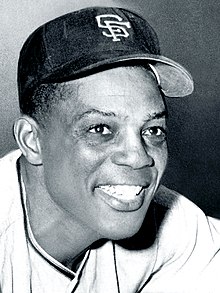
Willie Mays is tied with Roberto Clemente for the most Gold Gloves won by an outfielder, with 12 awards each.
The Rawlings Gold Glove Award, usually referred to as the Gold Glove, is the award given annually to the Major League Baseball players judged to have exhibited superior individual fielding performances at each fielding position in both the National League (NL) and the American League (AL), as voted by the managers and coaches in each league. Managers are not permitted to vote for their own players. Twenty-two Gold Gloves are awarded each year (with the exception of 1957, 1985, 2007 and 2018), one at each of the nine positions, one for a utility player, and one for a team as a whole, in each respective league. In 1957, the baseball glove manufacturer Rawlings created the Gold Glove Award to commemorate the best fielding performance at each position. The award was created from a glove made from gold lamé-tanned leather and affixed to a walnut base. Initially, only one Gold Glove per position was awarded to the top fielder at each position in the entire major league; however, separate awards were given for the National and American Leagues beginning in 1958.
The phrase "at each position" was not strictly accurate until 2011, when the awards were changed to specify individual awards for left fielder, center fielder, and right fielder. Previously, the prize was presented to three outfielders irrespective of their specific position. Any combination of outfielders, often three center fielders, could win the award in the same year. Critics called for awarding a single Gold Glove for each individual outfield position, arguing that the three outfield positions are not equivalent defensively. In the 1985 American League voting, a tie for third-place resulted in the presentation of Gold Glove Awards to four outfielders (Dwayne Murphy, Gary Pettis, Dwight Evans and Dave Winfield); this scenario was repeated in the National League in 2007 (Andruw Jones, Carlos Beltrán, Aaron Rowand, and Jeff Francoeur). Father and son Bobby and Barry Bonds are the only family pair who have won Gold Glove Awards as outfielders. (Full article...) -
Image 7

In baseball, a home run is credited to a batter when he hits a fair ball and reaches home safely on the same play, without the benefit of an error. Sixty-two different players have hit two home runs in an inning of a Major League Baseball (MLB) game to date, the most recent being Brent Rooker of the Oakland Athletics on May 4, 2024. Regarded as a notable achievement, five players have accomplished the feat more than once in their career; no player has ever hit more than two home runs in an inning. Charley Jones was the first player to hit two home runs in one inning, doing so for the Boston Red Stockings against the Buffalo Bisons on June 10, 1880.
These innings have resulted in other single-inning and single-game MLB records being set due to the prodigious offensive performance. Bobby Lowe and Mike Cameron finished their respective games with a total of four home runs, equaling the record for most home runs in one game. Both of the home runs hit by Fernando Tatís in the third inning for the St. Louis Cardinals on April 23, 1999, were grand slams. Not only did he tie the record for most grand slams in one game, Tatís became the only player to hit two grand slams in the same inning and established a new major league record with eight runs batted in (RBI) in a single inning. A decade later, Alex Rodriguez set the single-inning American League record for RBIs with seven when he hit a three-run home run and a grand slam in the sixth inning for the New York Yankees on October 4, 2009. (Full article...) -
Image 8

In baseball, a run batted in (RBI) is awarded to a batter for each runner who scores as a result of the batter's action, including a hit, fielder's choice, sacrifice fly, sacrifice bunt, catcher's interference, or a walk or hit by pitch with the bases loaded. A batter is also awarded an RBI for scoring himself upon hitting a home run. Sixteen players have batted in at least 10 runs in a single Major League Baseball (MLB) game to date, the most recent being Shohei Ohtani of the Los Angeles Dodgers on September 19, 2024. No player has accomplished the feat more than once in his career and no player has ever recorded more than 12 RBIs in a game. Wilbert Robinson was the first player to record at least 10 RBIs in a single game, driving in 11 runs for the Baltimore Orioles against the St. Louis Browns on June 10, 1892.
As of 2024[update], every team that has had a player achieve the milestone has won the game in which it occurred. These games have resulted in other single-game MLB records being set due to the prodigious offensive performance. Robinson, for example, also amassed seven hits in that same game, setting a new major league record that has since been tied by only one other player. Mark Whiten hit four home runs to complement his 12 RBIs for the St. Louis Cardinals on September 7, 1993, tying the single-game records in both categories. By attaining both milestones, he became one of only two players to hit four home runs and drive in 10 or more runs in the same game, with Scooter Gennett being the other. Tony Lazzeri, Rudy York, and Nomar Garciaparra hit two grand slams during their 10 RBI game, equaling the record for most grand slams in one game. Norm Zauchin has the fewest career RBIs among players who have 10 RBIs in one game with 159, while Alex Rodriguez, with 2,086, drove in more runs than any other player in this group and hit the third most in major league history. (Full article...) -
Image 9
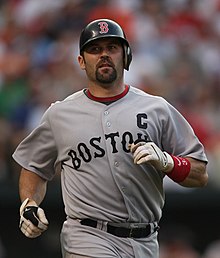
An All-American team is an honorary sports team composed of the best amateur players of a specific season for each position—who in turn are given the honorific "All-America" and typically referred to as "All-American athletes", or simply "All-Americans". Although the honorees generally do not compete as a unit, the term is used in U.S. team sports to refer to players who are selected by members of the national media. Walter Camp selected the first All-America team in the early days of American football in 1889. In 1950, the American Baseball Coaches Association (ABCA) selected its first All-American baseball team. It has since chosen All-American teams and a player of the year for each division (National Collegiate Athletic Association (NCAA) Division I, Division II, Division III, National Association of Intercollegiate Athletics, junior college, and high school). Collegiate Baseball selects All-American, Freshman All-American, and High School All-American teams. Baseball America magazine selects pre-season and post-season All-American teams and College Player of the Year honorees.
Various organizations selected All-American lists of the best players for the 1994 NCAA Division I college baseball season. The ABCA, the magazine Baseball America, and Collegiate Baseball were the NCAA-sanctioned selectors. This list only includes players selected to the post-season All-American first team for each selector. However, many All-American selections choose second, third, etc. teams from the remaining eligible candidates. (Full article...) -
Image 10

In baseball, a home run is credited to a batter when they hit a fair ball and reach home safely on the same play, without the benefit of an error. 136 players have hit a home run in their first at bat of a Major League Baseball (MLB) game, the most recent being Jhonkensy Noel of the Cleveland Guardians on June 26, 2024. George Tebeau and Mike Griffin both hit home runs in their first at bats on April 16, 1887. These players are recognized together as the first player to homer in his first major league at bat because it is unknown which one hit first.
Luke Stuart, Walter Mueller, and Johnnie LeMaster hit inside-the-park home runs in their first at bats. Bill Duggleby, Jeremy Hermida, Brandon Crawford, Kevin Kouzmanoff and Daniel Nava hit grand slams in their first at bats—Kouzmanoff and Nava doing so on the first pitch. Ernie Koy and Heinie Mueller were the first players to accomplish the feat in the same game, doing so for the Brooklyn Dodgers and Philadelphia Phillies, respectively, in the first inning of Opening Day in 1938. This was equalled in 2016 by Tyler Austin and Aaron Judge, who became the only players to achieve the feat as teammates (playing for the New York Yankees) and in back-to-back at bats. Two players, Bob Nieman and Keith McDonald, each homered in their second at bat also. Paul Gillespie and John Miller are the only players to hit home runs in both their first and last major league at bats; for Miller these were the only two home runs of his MLB career. For 23 players, their first at bat home run was the only home run of their major league careers, and Gary Gaetti hit more home runs (360) than any other player who hit one in their first at bat. (Full article...) -
Image 11

The 1980 Sounds set a team-best 97–46 (.678) record playing as the Double-A affiliate of the New York Yankees in the Southern League.
The Nashville Sounds Minor League Baseball team has played in Nashville, Tennessee, for 47 years since being established in 1978. As of the completion of the 2024 season, the club has played 6,566 regular-season games and compiled a win–loss record of 3,398–3,168–2 (.518). They have appeared in the postseason on 16 occasions in which they have a record of 49–44 (.527) in 93 games. Combining all 6,659 regular-season and postseason games, Nashville has an all-time record of 3,447–3,212–2 (.518).
Created as an expansion team of the Double-A Southern League (SL) in 1978, the Sounds played in this league through 1984. At the Double-A classification, Nashville was affiliated with Major League Baseball's Cincinnati Reds (1978–1979) and New York Yankees (1980–1984). The Sounds moved up to Triple-A in 1985 as members of the American Association (AA) before joining the Pacific Coast League (PCL) in 1998. They were placed in the Triple-A East (AAAE) in 2021, but this became the International League (IL) in 2022. At this level, they have been affiliates of the Detroit Tigers (1985–1986), Cincinnati Reds (1987–1992), Chicago White Sox (1993–1997), Pittsburgh Pirates (1998–2004), Milwaukee Brewers (2005–2014), Oakland Athletics (2015–2018), and Texas Rangers (2019–2020). The Sounds reaffiliated with the Milwaukee Brewers in 2021. (Full article...) -
Image 12The New York Mets are a professional Major League Baseball (MLB) franchise based in New York City, New York in the borough of Queens. They play in the National League East division. In the history of the Mets, there have been 23 managers that managed a game including four interim managers. Of those managers, only Joe Torre was a player-manager (a manager who also plays for the team); Yogi Berra did play four games while he was a coach for the Mets in 1965. Gil Hodges, Roy McMillan, Bud Harrelson, Mike Cubbage, Dallas Green, Bobby Valentine and Willie Randolph all also played in MLB for the Mets prior to becoming the team's manager.
The Mets posted their franchise record for losses in their inaugural season in the league, with 120 losses in 160 games in 1962. This was the first of seven consecutive losing seasons, a season in which the winning percentage was below .500, and the most losses by a post-1900 MLB team. During this stretch from 1962 to 1968, the Mets employed four managers. Seven managers have taken the Mets to the postseason; Davey Johnson, Bobby Valentine and Terry Collins have led the team to two playoff appearances each. Johnson and Gil Hodges are the only Mets managers to win a World Series: Hodges in 1969 against the Baltimore Orioles; and Johnson in 1986 against the Boston Red Sox. Terry Collins is the longest-tenured manager in franchise history, with 1,134 games of service over 7 seasons. (Full article...) -
Image 13

Team photograph of the 1888 Kansas City Cowboys
The Kansas City Cowboys were a professional baseball team based in Kansas City, Missouri that played in the American Association for two seasons from 1888 to 1889. The franchise initially used Association Park as their home field in 1888, then moved to Exposition Park for the 1889 season.
The team began the 1888 season with part-time outfielder Dave Rowe as their player-manager. He was released from the team after beginning the season with a win–loss record of 14–36 though 50 games. He was replaced with second baseman Sam Barkley, who did not improve the team's play, winning 22 of the next 58 games. He was replaced with non-playing manager Bill Watkins, who finished the season. Although the Cowboys completed their initial season in last place out of the league's eight teams, there were notable player achievements; on June 6, Henry Porter threw a no-hitter, and on June 13, Barkley hit for the cycle. (Full article...) -
Image 14

Craig Biggio (1987) is the only first-round draft pick of the Astros with over 3000 career hits.
The Houston Astros, originally called the "Colt .45s", are a Major League Baseball (MLB) franchise based in Houston, Texas. They play in the American League West division. Since the institution of Major League Baseball's Rule 4 Draft, the Astros have selected 57 players in the first round. Officially known as the "First-Year Player Draft", the Rule 4 Draft is Major League Baseball's primary mechanism for assigning amateur baseball players from high schools, colleges, and other amateur baseball clubs to its franchises. The draft order is determined based on the previous season's standings, and the team that had the worst record receives the first pick. In addition, teams which lost free agents in the previous off-season may be awarded compensatory or supplementary picks. The First-Year Player Draft is unrelated to the 1961 expansion draft in which the Astros initially filled their roster.
Of the 57 players picked in the first round by Houston, 24 have been pitchers, the most of any position; 21 of these were right-handed, while 3 were left-handed. Ten catchers were selected, while nine outfielders, nine shortstops, two first basemen, and two third basemen were taken as well. The team also selected one player at second base. Thirteen of the players came from high schools or universities in the state of California, while Texas and Tennessee follow with five and three players, respectively. They have also drafted two players from outside the United States: Carlos Correa (2012) and Ramón Castro (1994), both from Puerto Rico. (Full article...) -
Image 15

Randy Johnson pitched for the Diamondbacks from 1999 to 2004 and from 2007 to 2008.
The Arizona Diamondbacks are a Major League Baseball team based in Phoenix, Arizona. The Diamondbacks are part of the National League and play in the West Division. Since beginning play in the 1998 season, the Diamondbacks called Chase Field (formerly named "Bank One Ballpark") their home. The name "Diamondbacks" was inspired by the Western diamondback snake and was chosen among thousands of entries in a contest to name the team.
Arizona made their Major League debut in the 1998 baseball season when they became the 14th expansion team. After going 65–97 in their first season, the Diamondbacks were the National League West Division Champions in the 1999 baseball season when they went 100–62. They made it to the National League Division Series but they lost to the New York Mets. The early success of the franchise was exemplified in 2001 when the Diamondbacks defeated the New York Yankees in a dramatic seven game World Series in 2001. In the 2002 baseball season, Arizona returned to the playoffs but were defeated by the St. Louis Cardinals in the National League Division Series. Post season baseball did not return to the desert until the 2007 season when Arizona lost to the Colorado Rockies in the National League Championship Series. The following season, Arizona narrowly missed the playoffs, when they finished 2 games behind the Los Angeles Dodgers. In 2011, the Diamondbacks won their division but were ousted by the Milwaukee Brewers in the National League Division Series. In 2017, the Arizona Diamondbacks finished 2nd in the NL West, and they played in the National League Wild Card Game against the Rockies. This would be the team's first appearance in the postseason as a Wild Card team. Arizona won 11–8 and played the Dodgers in the NLDS that year but were swept in 3 games. (Full article...)
More did you know
- ... that Negro league baseball executive Cum Posey organized the East-West League in 1932, but the league folded before the end of the season?
- ... that Freeman Fitzgerald played football with Knute Rockne and once struck out 19 batters in a baseball game?
- ... that despite being named one of the "top prospects of the decade" by Baseball America, American baseball pitcher Nick Neugebauer compiled a career record of just two wins and eight losses?
- ... that Milwaukee Brewers baseball player Dan Thomas was called the "Sundown Kid" because he refused to play on Sabbath?
- ... that when Roger Bresnahan adopted the use of shin guards in Major League Baseball on Opening Day in 1907, angry fans threw snow onto the field?
Sports portals
Selected picture
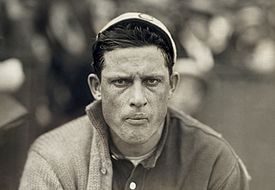
| Credit: Paul Thompson |
Edward Augustine Walsh (May 14, 1881 – May 26, 1959) was a Major League Baseball pitcher. He holds the record for lowest career ERA, 1.82. Born in Plains Township, Pennsylvania, Walsh had a brief though remarkable major league career. He made his major league debut in 1904 with the Chicago White Sox and pitched his first full season in 1906, going 17-13 with a 1.88 ERA and 171 strikeouts.
Associated Wikimedia
The following Wikimedia Foundation sister projects provide more on this subject:
-
Commons
Free media repository -
Wikibooks
Free textbooks and manuals -
Wikidata
Free knowledge base -
Wikinews
Free-content news -
Wikiquote
Collection of quotations -
Wikisource
Free-content library -
Wikiversity
Free learning tools -
Wiktionary
Dictionary and thesaurus
More portals
- Portals with triaged subpages from June 2018
- All portals with triaged subpages
- Portals with no named maintainer
- Automated article-slideshow portals with 51–100 articles in article list
- Automated article-slideshow portals with 501–1000 articles in article list
- Random portal component with 41–50 available subpages
- Automated article-slideshow portals with 201–500 articles in article list
- Random portal component with 11–15 available subpages
- Random portal component with 21–25 available image subpages

